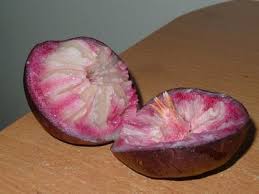GOOD
STAR APPLE

Round, baseball sized fruit that when cut has a core that takes on a star shape. Pulp is soft and sweet. The star apple usually comes in two forms, either the dark purple skinned variety with red-purple pulp, or the green skinned variety with clear-white pulp. The star apple is a very popular fruit in many tropical parts of the world.Description: A medium to large sized tree from 25-80ft high. Leaves are very pretty, with a glossy green surface, and a shimmering gold velvety underside.Hardiness: Star apples are tropical, and will not survive more than a couple of degrees of frost.Growing Environment: Young trees are highly susceptible to any kind of frost or cold wind. Trees need balanced watering throughout the year.Propagation: Either by seeds, which take 5-10 years to bear, or by grafting and budding, with trees coming to bear in 2-4 years.Uses: Star apples are eaten fresh. The pulp is usually spooned out as to avoid the bitter tasting rind. The fresh fruit is also often added to salads, drinks, and other dishes.Native Range: Native to tropical America, from the Caribbean through Central America. Is now grown commercially in Central and South America as well as tropical Asia and Africa. Occasionally grown commercially in parts of south Florida.
"Hawaiian Fruit - Star Apple." InstantHawaii - Your Big Island of Hawai'i Information and Activity Portal. Web. 14 Feb. 2012.
.
BADMOONSEED-very toxic to humans!!!! Moonseed is a woody vine with cluster of several small fruits, or drupes, which
Moonseed is a woody vine with cluster of several small fruits, or drupes, which
resemble grapes. It is native to eastern North America where it is found in
woods and hedges, but fortunately not commonly. The key to recognizing moonseed
drupes is that they have only one large crescent-shaped seed, while grapes have
many seeds. Birds eat the drupes with no apparent harm, which only shows that it
isn’t always safe to eat what birds eat. These drupes are poisonous, producing
severe abdominal pain and indigestion."Poisonous Plants — Moonseed.Moonseed, a deciduous climbing vine, is fairly common throughout North
Carolina in floodplain forests and other moist wooded areas.Drooping panicles of tiny white flowers appear in mid- to late-spring. The leaves and all other parts of the plant are toxic. " Mount Lehman Llamas. Web. 14 Feb. 2012. .
"Moonseed (Menispermum Canadense)." Home Duke University. Web. 14 Feb. 2012. .
T.Murray) how is the star apple considered a good plant?
ReplyDeleteR. Sharp
ReplyDeleteWhat are both your plant's scientific names?
K. Buell
ReplyDeleteWhat is the phylum and scientific name for your star apple plant? Same for your moon seed?
M. McKee
ReplyDeleteHow can you tell your red berried moon seed plant be told apart from other red berried plant?
Z. Carter
ReplyDeleteWhat phylum are your plants from?
Mrs. Hauck - What is a floodplain forest?
ReplyDeleteK.Marlow
ReplyDeleteCan the Moonseed toxin cause death to a person if he/she eat a lot of them?
K.Ireton)yes even touching the plant can get you sick.
Deletet.pancake
ReplyDeleteis there any nickmanes that they have?
Z.Mullins
ReplyDeletewhat enables your good plantto have two diffrent apperances
H. Willoughby
ReplyDeleteHave you ever eaten a star apple?
D. Torok
ReplyDeleteCan the poison only spread when ingested?
T.Lee
ReplyDeleteIs the star fruit related in any way to the cocunut?
T. Atkins
ReplyDeleteWhat in the plant actually causes humans to be poisoned?
B.Flottman
ReplyDeletewhat are their scientific names?
S. Tumbleson
ReplyDeleteIf someone were to eat this plant, how would they have to be treated?
S.Sanders
ReplyDeleteIs there a mortality rate of humans with your bad plant that have contacted it?
J.Planck
ReplyDeleteDid you find or do you know what the STAR APPLE tastes like?
P.Kinnair
ReplyDeleteare there any benefits to eating the star apple?